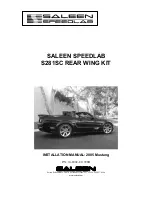
S0X4AA0E10400000000CAAT00
General Operation
Torque Converter, Gears, and Clutches
Electronic Control
Hydraulic Control
Shift Control Mechanism
Lock-up Mechanism
14-18
Automatic Transmission
System Description
The automatic transmission is a combination of a 3-element torque converter and triple-shaft electronically controlled
unit which provides 4 speeds forward and 1 reverse. The entire unit is positioned in line with the engine.
The torque converter consists of a pump, turbine, and stator assembly in a single unit. The converter housing (pump)
is connected to the engine crankshaft and turn as the engine turns. Around the outside of the torque converter is a ring
gear which meshes with the starter pinion when the engine is being started. The entire torque converter assembly
serves as a flywheel, transmitting power to the transmission mainshaft. The transmission has three parallel shafts: the
mainshaft, the countershaft, and the secondary shaft. The mainshaft is in line with the engine crankshaft. The
mainshaft includes the 3rd and 4th clutches, and gears for 3rd, 4th, reverse, and idler (reverse gear is integral with the
4th gear). The countershaft includes the final drive, 1st, 3rd, 4th, reverse, 2nd, park, and idler gears (the final drive gear
is integral with the countershaft). The secondary shaft includes the 1st and 2nd clutches, and gears for 1st, 2nd, and
idler. The countershaft 4th gear and the countershaft reverse gear can be locked to the countershaft at its center,
providing 4th gear or reverse, depending which way the selector moved. The gears on the mainshaft and the
secondary shaft are in constant mesh with those on the countershaft. When certain combinations of gears in the
transmission are engaged by the clutches, power is transmitted through the mainshaft, then to the secondary shaft to
the countershaft to provide drive.
The electronic control system consists of the powertrain control module (PCM), sensors, and six solenoid valves.
Shifting and lock-up are electronically controlled for comfortable driving under all conditions. The PCM is located
below the dashboard, under the front lower panel behind the center console.
The valve bodies include the main valve body, the regulator valve body, the servo body, and the accumulator body.
They are bolted to the torque converter housing. The main valve body contains the manual valve, the modulator valve,
the shift valve C, the shift valve D, the shift valve E, the servo control valve, the torque converter check valve, the
reverse Clutch Pressure Control C (CPC) valve, the lock-up shift valve, the relief valve, the cooler check valve, and the
ATF pump gears. The regulator valve body contains the regulator valve, the lock-up timing valve, and the lock-up
control valve. The servo body contains the servo valve, the shift valve A, the shift valve B, the CPC valves A and B, and
3rd and 4th accumulators. The accumulator body contains the 1st and 2nd accumulators and lubrication check valve.
Fluid from the regulator passes through the manual valve to the various control valves. The 1st, 3rd, and 4th clutches
receive fluid from their respective feed pipes, and the 2nd clutch receives fluid from the internal hydraulic circuit.
To shift gears, the PCM controls shift solenoid valves A, B, and C, and A/T clutch pressure control solenoid valves A
and B while receiving input signals from various sensors and switches located throughout the vehicle. The shift
solenoid valves shift the positions of the shift valves to switch the port leading hydraulic pressure to the clutch. The
A/T clutch pressure control solenoid valves A and B control the CPC valves A and B to shift smoothly between lower
gear and higher gear. This pressurizes a line to one of the clutches, engaging the clutch and its corresponding gear.
The lock-up mechanism operates in the D4 position (3rd and 4th) and D3 position (3rd). The pressurized fluid is
drained from the back of the torque converter through a fluid passage, causing the torque converter clutch piston to be
held against the torque converter cover. As this takes place, the mainshaft rotates at the same speed as the engine
crankshaft. Together with hydraulic control, the PCM optimizes the timing of the lock-up mechanism. When the torque
converter clutch solenoid valve activates, modulator pressure changes to switch lock-up on and off. The lock-up
control valve and the lock-up timing valve control the amount of lock-up according to A/T clutch pressure control
solenoid valves A and B. The torque converter clutch solenoid valve is mounted on the torque converter housing, and
A/T clutch pressure control solenoid valves A and B are mounted on the transmission housing. They are all controlled
by the PCM.
03/07/29 09:29:18 61S0X050_140_0021
Summary of Contents for 2004 Odyssey
Page 33: ......
Page 59: ......
Page 145: ......
Page 167: ......
Page 229: ......
Page 259: ......
Page 283: ......
Page 309: ......
Page 613: ...03 07 29 09 29 07 61S0X050_140_0003...
Page 1097: ......
Page 1119: ......
Page 1363: ......
Page 1527: ...Top View 20 162 Frame Frame Repair Chart...
Page 1528: ...20 163 cont d...
Page 1529: ...Side View 20 164 Frame Frame Repair Chart cont d...
Page 1530: ...20 165...
Page 1594: ...21 63...
Page 1606: ...21 75...
Page 1677: ......
Page 1692: ...22 13 Roof REAR CONTROLLER and SCREEN With rear entertainment system...
Page 1696: ...22 17 1 2 BATTERY GROUND CABLE 3 4 5 6 ENGINE GROUND CABLE STARTER CABLE...
Page 2025: ......
Page 2439: ......
Page 2459: ......
















































